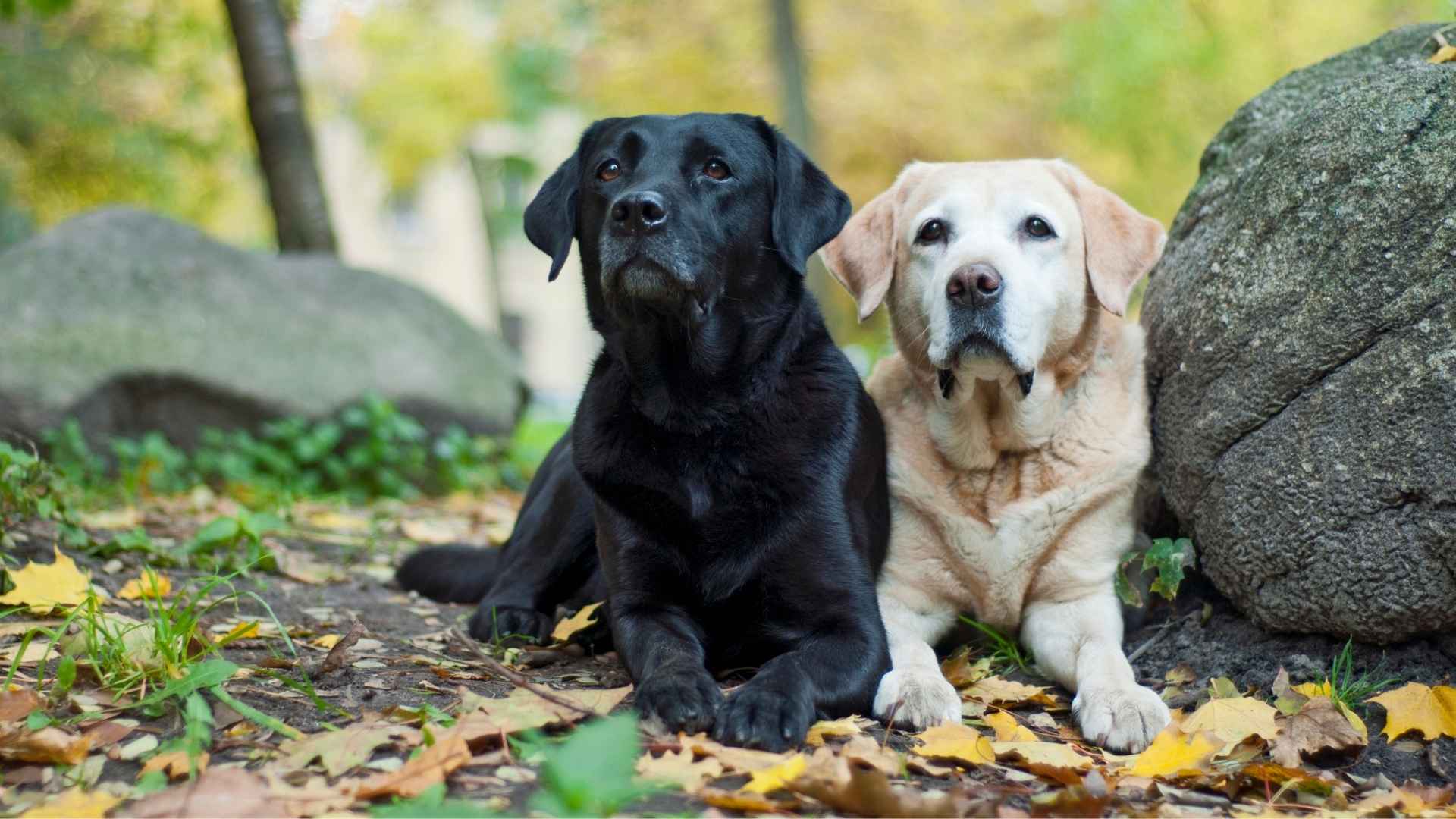Bringing a dog into your life is an act of love and a long-term commitment. While the joy and companionship dogs provide are immeasurable, it’s essential to think ahead and understand just how many years you’ll likely be spending with your new furry friend. Life circumstances can change, and knowing the typical lifespan of a breed can help ensure you’re choosing a pet whose needs and longevity align with your future plans.
Dog lifespans can vary greatly depending on size, genetics, and breed-specific health conditions. On average, dogs live around 14 years, but some canines have been known to reach their 20s with proper care and a bit of luck. Smaller dog breeds tend to outlive their larger counterparts, often enjoying lifespans between 12 and 16 years, while large or giant breeds may live anywhere from 7 to 12 years.
Whether you’re hoping for a decade-long companion or planning for even longer, it helps to know what to expect. In this article, we’ll explore various dog breeds and their average lifespans, helping you make an informed, heartfelt decision about your next loyal companion.
Average Lifespan Dog Breeds
1. Bernese Mountain Dog
Despite their massive size and majestic presence, the Bernese Mountain Dog is a gentle and affectionate companion. Originally bred in the Swiss Alps for drafting and herding, this breed transitioned to American farms in the 1920s and has since become a beloved family pet.
These towering dogs, ranging from 23 to 27.5 inches in height and weighing between 70 and 115 pounds, are known for their patient demeanor, love of play, and affectionate nature with both humans and other pets.
The Bernese Mountain Dog is typically a loving and smart breed, as per PetMD. Though they appear calm and composed, they need regular activity and plenty of companionship to stay emotionally and physically healthy.
Health
As with many large breeds, the Bernese Mountain Dog has a relatively short lifespan, averaging 7 to 10 years. While generally hearty, they are prone to joint issues like hip and elbow dysplasia, particularly if they grow too quickly as puppies.
Obesity can worsen these problems, making balanced nutrition and steady growth crucial. Additionally, their thick tricolor coat requires diligent grooming and sheds year-round. These dogs may struggle with separation anxiety and are best suited to homes where they’re rarely left alone.
Fact: Bernese Mountain Dogs originated in Switzerland and were brought to the U.S. in the 1920s to work on farms.
2. Rottweiler
Strong, confident, and undeniably loyal, the Rottweiler has long been cherished as a dependable working dog. According to the AKC, the Rottweiler is a devoted, affectionate, and self-assured protector. With roots tracing back to ancient Roman mastiffs, this large breed was originally bred to herd livestock and pull carts.
Today, they rank among the most popular dogs in the U.S. Male dogs typically stand 24 to 27 inches tall and weigh 95 to 135 pounds, while female dogs range from 22 to 25 inches and 80 to 100 pounds. Despite their commanding presence, Rottweilers are affectionate family companions when trained and socialized properly. Their average lifespan is around 9 to 10 years.
Health
Rottweilers require consistent veterinary care to manage a range of potential health concerns. Obesity is a notable risk, exacerbating issues like hip and elbow dysplasia, conditions that may cause limping, pain, and arthritis if untreated.
Cranial cruciate ligament (CCL) ruptures are also common, often needing surgery and rehabilitation. Keeping your Rottweiler at a healthy weight and avoiding high-impact play can help mitigate these risks.
Diet, portion control, and structured exercise play vital roles in maintaining their well-being and improving dog longevity.
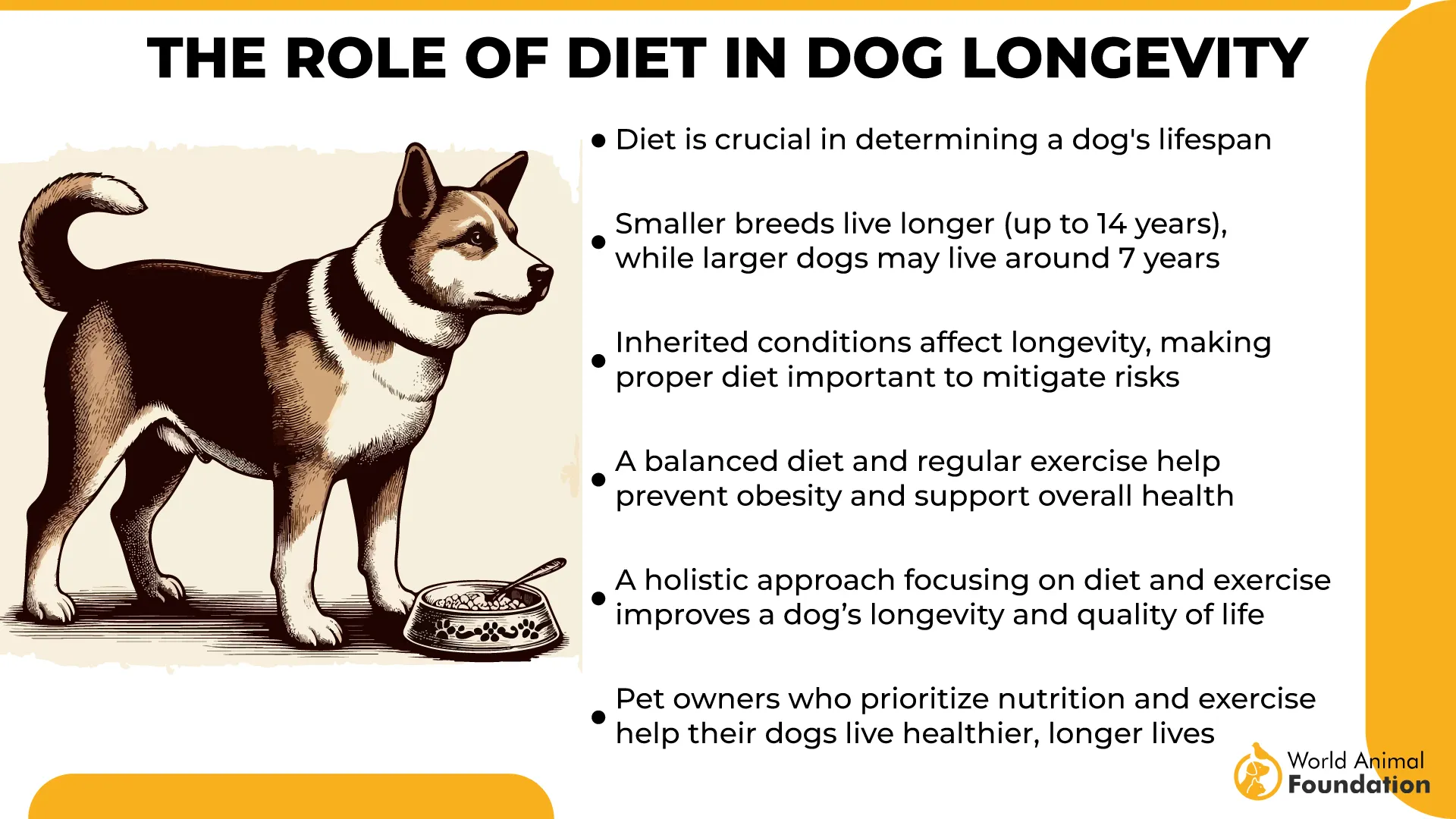
Fact: Rottweilers have strong, square muzzles and a shiny black coat with distinctive rust markings.
3. Great Dane
Known as the “Apollo of dogs,” the Great Dane is a towering, elegant breed that commands attention with both its size and gentle disposition. Purina describes the Great Dane as a breed that genuinely lives up to the nickname “gentle giant.”
First bred in 19th-century Germany for boar hunting and estate guarding, the Great Dane has since transformed into a devoted companion that thrives in family settings.
Standing among the tallest of dog breeds, these giants possess not only height but also big hearts, both figuratively and, in some cases, literally.
Health
Unfortunately, Great Danes are prone to a variety of health challenges that contribute to their lifespan of 7 to 10 years. One of the most dangerous conditions is bloat, a life-threatening gastric issue that may require surgical intervention to prevent recurrence.
They are also susceptible to cardiomyopathy, a disease causing the heart to enlarge, as well as hip dysplasia and osteoarthritis due to their large frames.
To support healthy breed development, Great Dane puppies should be fed large-breed-specific diets up to 18 months of age and may benefit from joint supplements like glucosamine and chondroitin throughout life.
Fact: Despite their name, Great Danes have no ties to Denmark and actually originated in Germany.
4. Irish Wolfhound
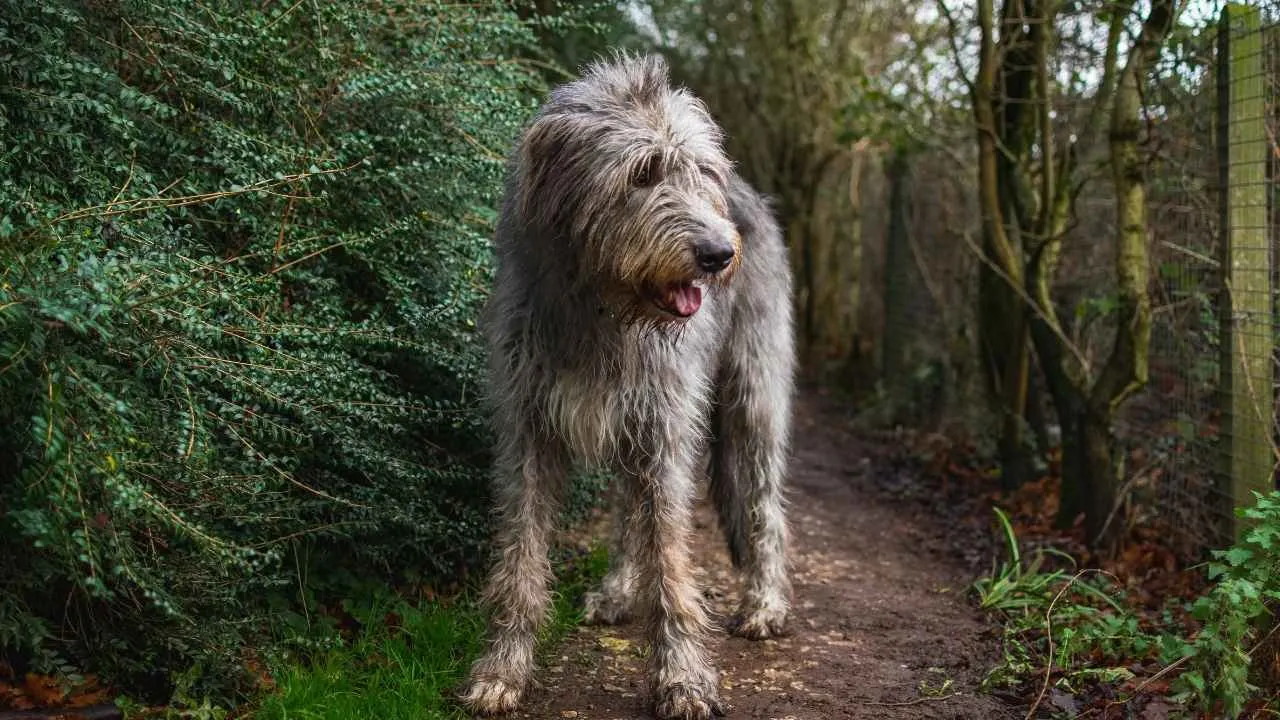
Known for their towering stature and noble bearing, the Irish Wolfhound is one of the tallest dog breeds in the world. Originally bred by combining Middle Eastern hounds with native British dogs, their earliest recorded mention dates back to 391 AD in a letter by a Roman statesman.
Historically used to hunt wolves in Ireland during the 1700s, these gentle giants have since become beloved household companions. Their calm and affectionate temperament makes them surprisingly well-suited for family life, provided there’s ample space to accommodate their size.
Standing a minimum of 20 inches tall and weighing at least 105 pounds, their size is both impressive and a contributing factor to their relatively short lifespan of 6–8 years. WebMD states that Irish Wolfhounds are gentle, devoted, and tranquil companions who thrive on being close to their family and receiving lots of affection.
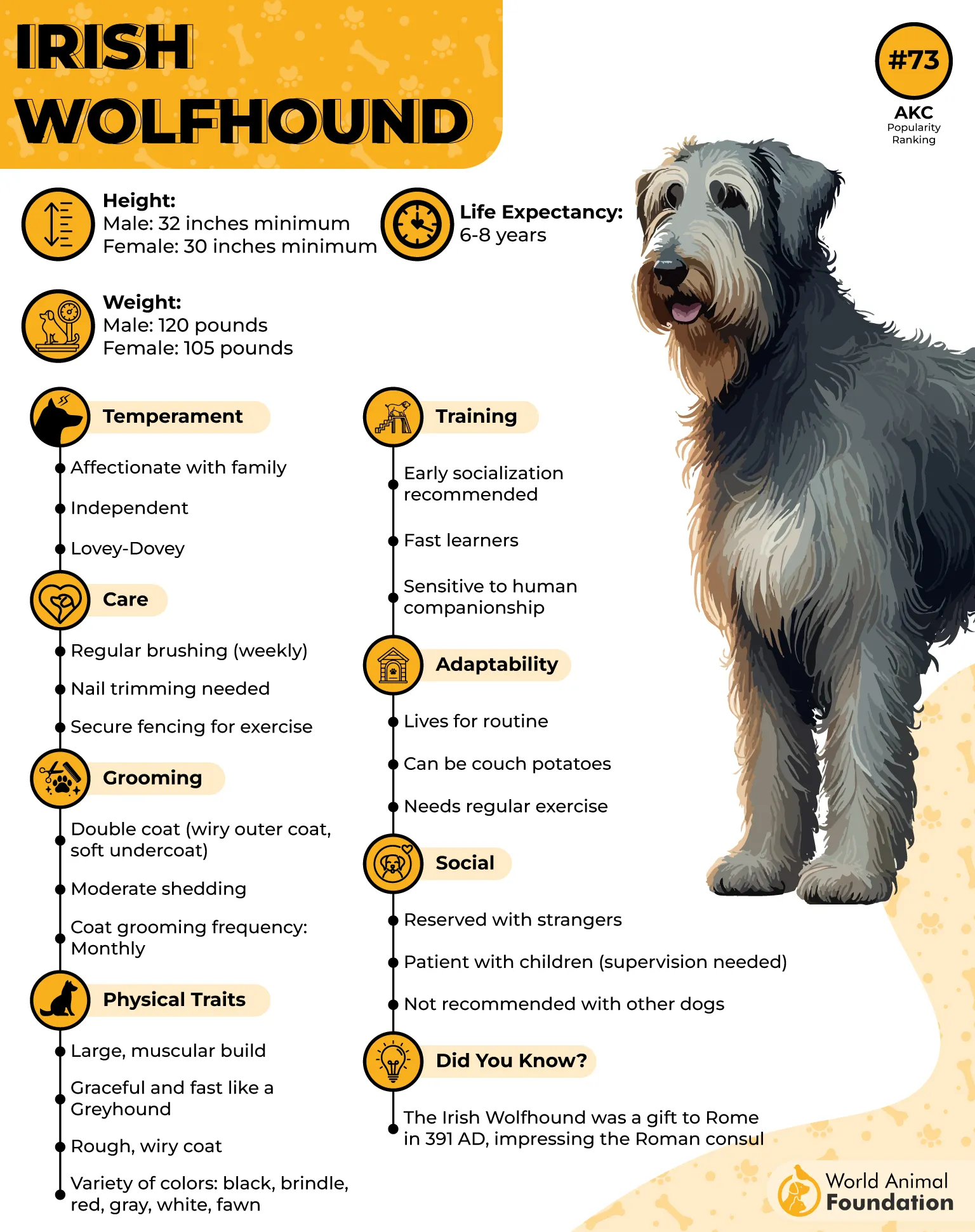
Health
Due to their large build, this calm dog breed faces several health challenges. Bloat, or gastric dilatation-volvulus, is a life-threatening risk common in giant breeds. Heart conditions like Irish Wolfhound type Cardiomyopathy (IWCM) and atrial fibrillation are also prevalent.
They are more likely than many breeds to develop bone cancer (osteosarcoma) and may be born with liver shunts that impair the body’s ability to filter blood. Routine veterinary monitoring is essential for early detection and care.
Fact: Irish Wolfhounds were originally bred to hunt wolves in 18th-century Ireland.
5. Mastiff
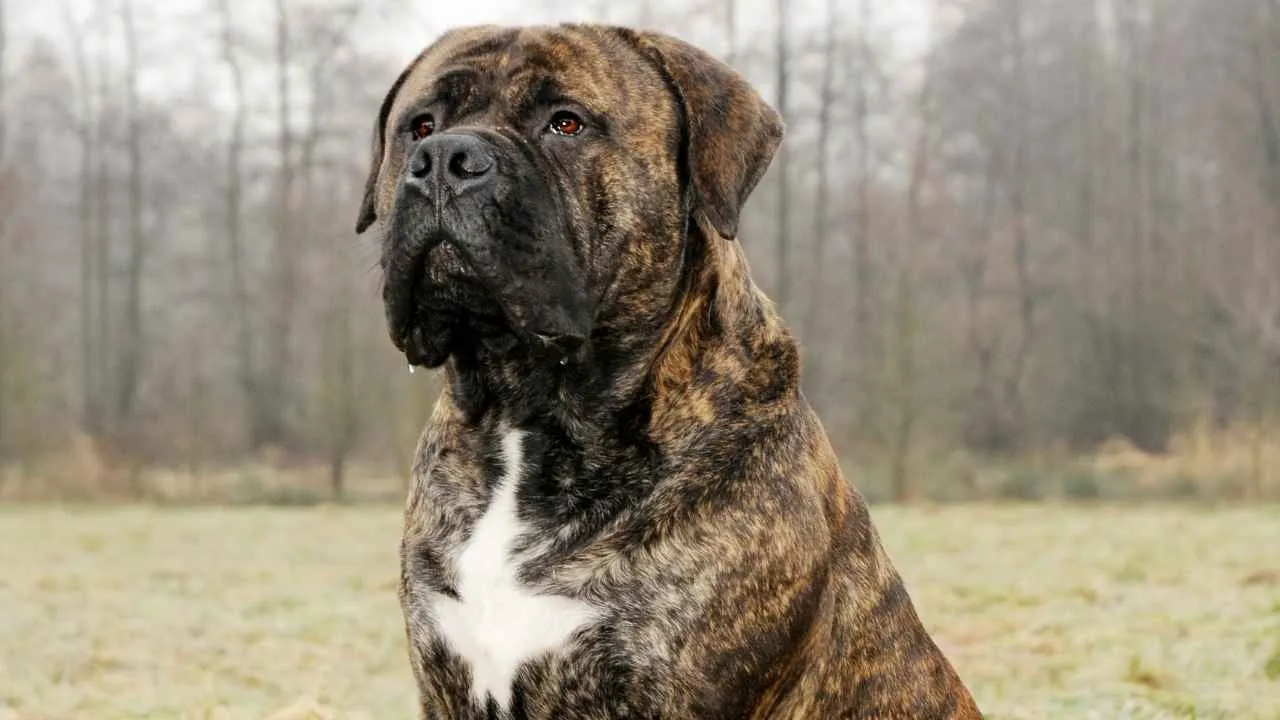
Mastiffs are calm and friendly gentle giants who usually get along well with others. Like all breeds, early socialization is key to helping them become confident and well-adjusted. While they only need weekly grooming, their facial folds require daily cleaning, as per PDSA.
Massive in both size and presence, the Mastiff is one of the most iconic giant breeds. Towering at 30 to 31 inches and weighing up to 200 pounds, these dogs are known for their imposing build and calm, protective demeanor. A historical companion, it’s believed that a Mastiff even sailed to America on the Mayflower.
Characterized by a broad, square head, drooping jowls, and a black facial mask, their powerful appearance is matched by their gentle nature. However, their unique physical structure has led to several inherited health challenges that can impact their average life expectancy.
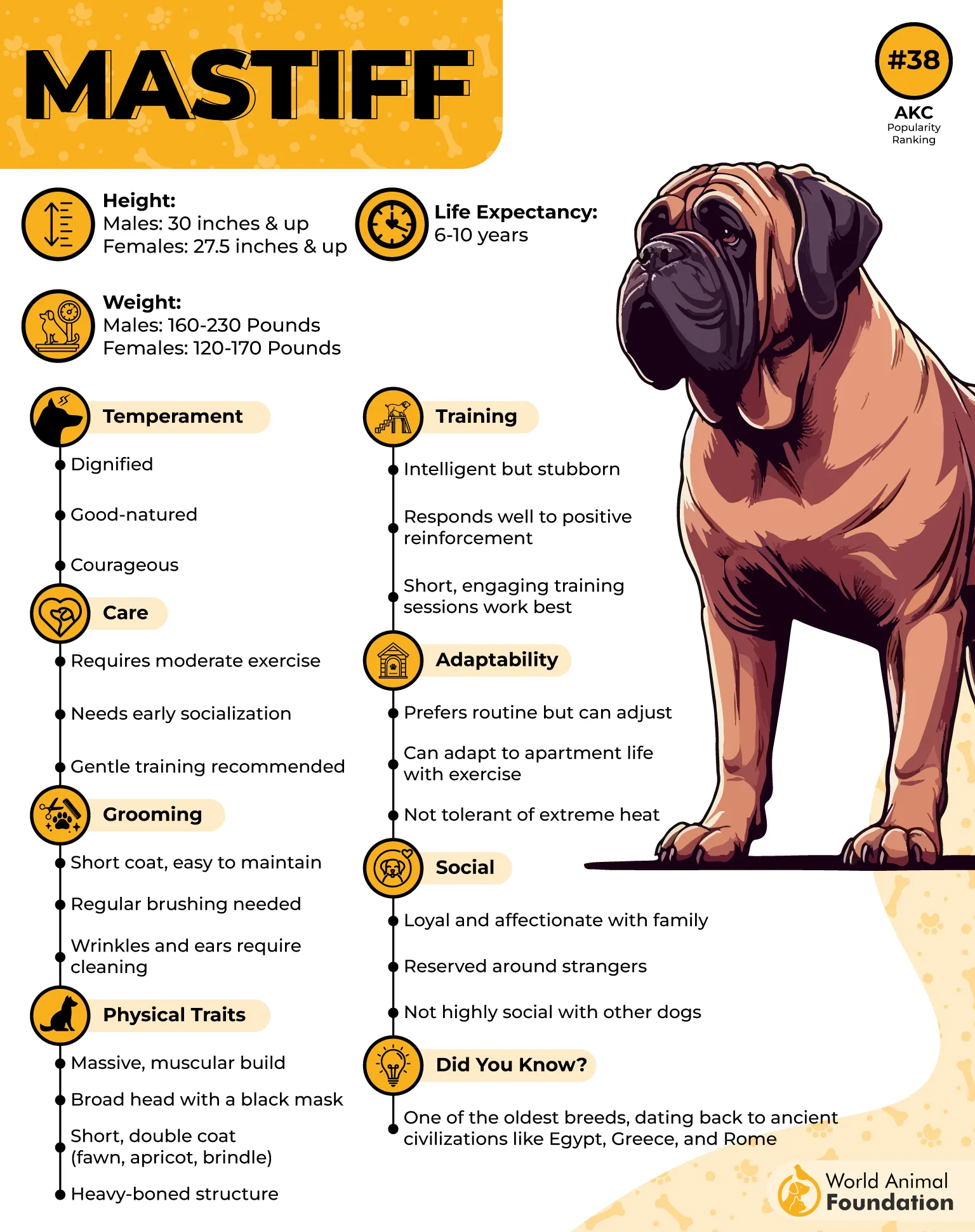
Health
Mastiffs typically live around 6 to 10 years. Due to their large frame and specific breeding, they are vulnerable to conditions like entropion and ectropion, where eyelids either roll inward or sag outward, irritating the eyes.
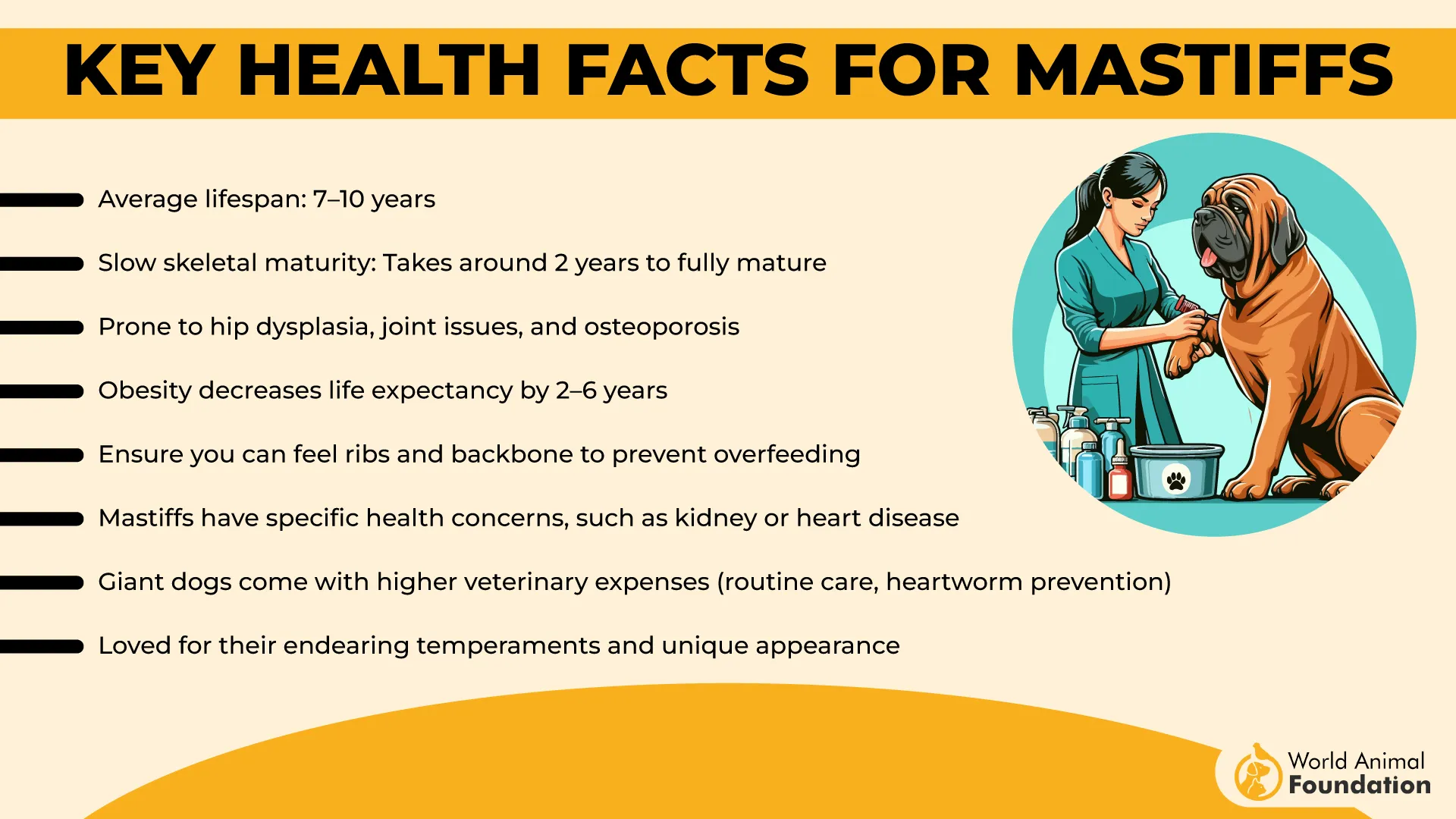
They’re also prone to cherry eye, a visible protrusion of the third eyelid, and gastric torsion (GDV), a life-threatening condition common in deep-chested breeds.
Additionally, dilated cardiomyopathy, a weakening of the heart muscles, can occur with little warning. Selective breeding efforts aim to reduce these risks, but early intervention and veterinary care remain essential.
Fact: This large dog breed is believed to have journeyed to America aboard the Mayflower.
6. Saint Bernard
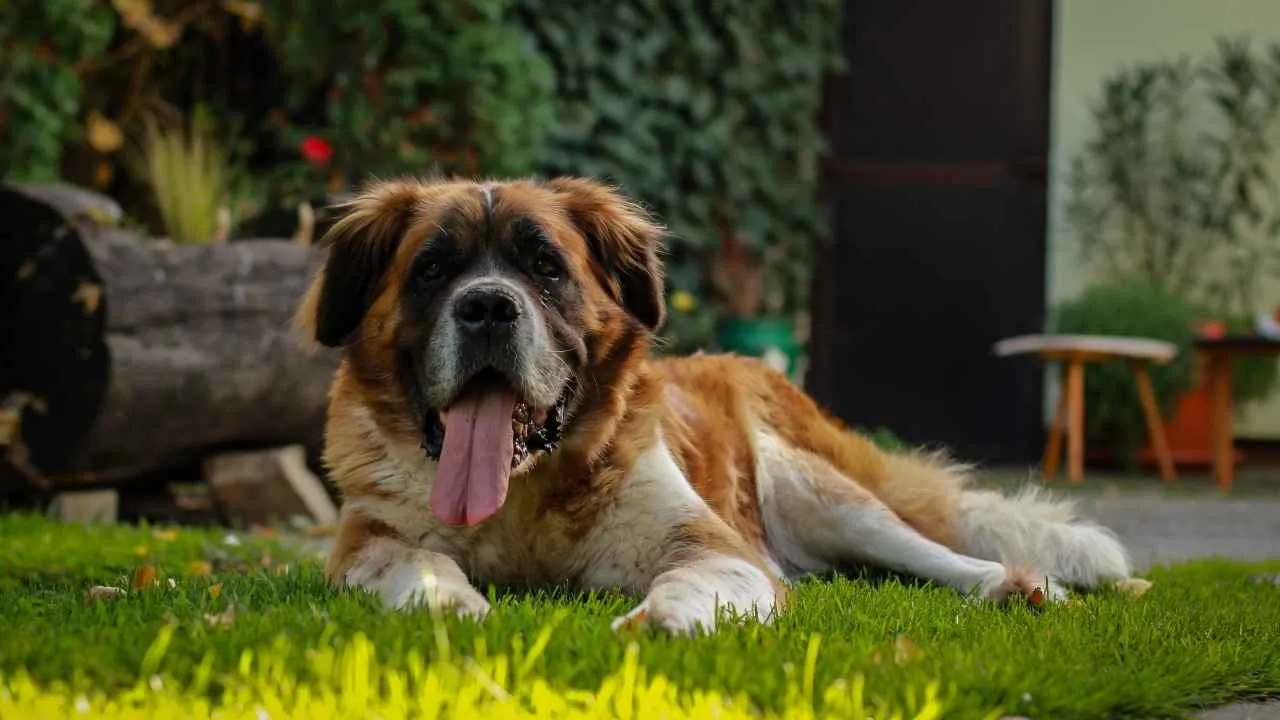
The Saint Bernard, affectionately known as the Bernie or Saint, is a giant breed with an equally enormous heart. Originally developed in the Swiss Alps to rescue stranded travelers from snowdrifts, this breed has evolved into a devoted family companion.
Their calm demeanor, affectionate nature, and love for human interaction make them beloved household pets. Though massive, routinely tipping the scales at over 100 pounds, these gentle giants are happiest lounging with their families, offering slobbery kisses and unwavering loyalty.
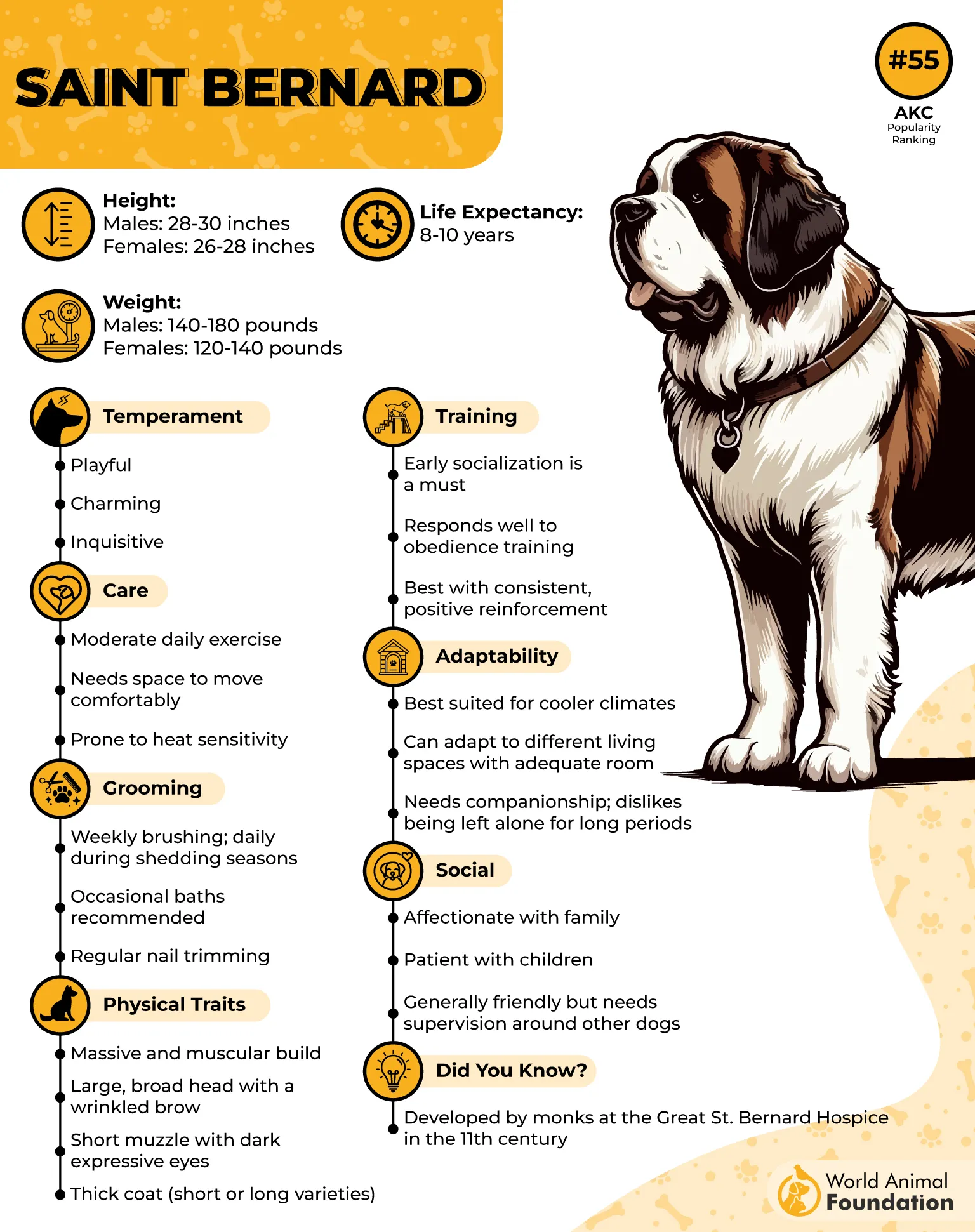
Health
This loyal dog breed generally lives between 8 to 10 years, which is typical for dogs of their size. However, due to their purebred lineage, they are susceptible to certain health concerns. Regular veterinary visits, especially after age seven, are crucial to catch age-related issues early.
Grooming needs depend on coat type (long or short), but both shed heavily, especially in spring and fall. Routine brushing, especially with a de-shedding tool during peak shedding season, keeps their thick double coat manageable.
Because of their size, weight management and joint care are essential. They also tend to drool quite a bit and may develop skin allergies if over-bathed.
Fact: These purebred dogs were originally bred to rescue snowbound travelers in the Swiss Alps.
7. Leonberger
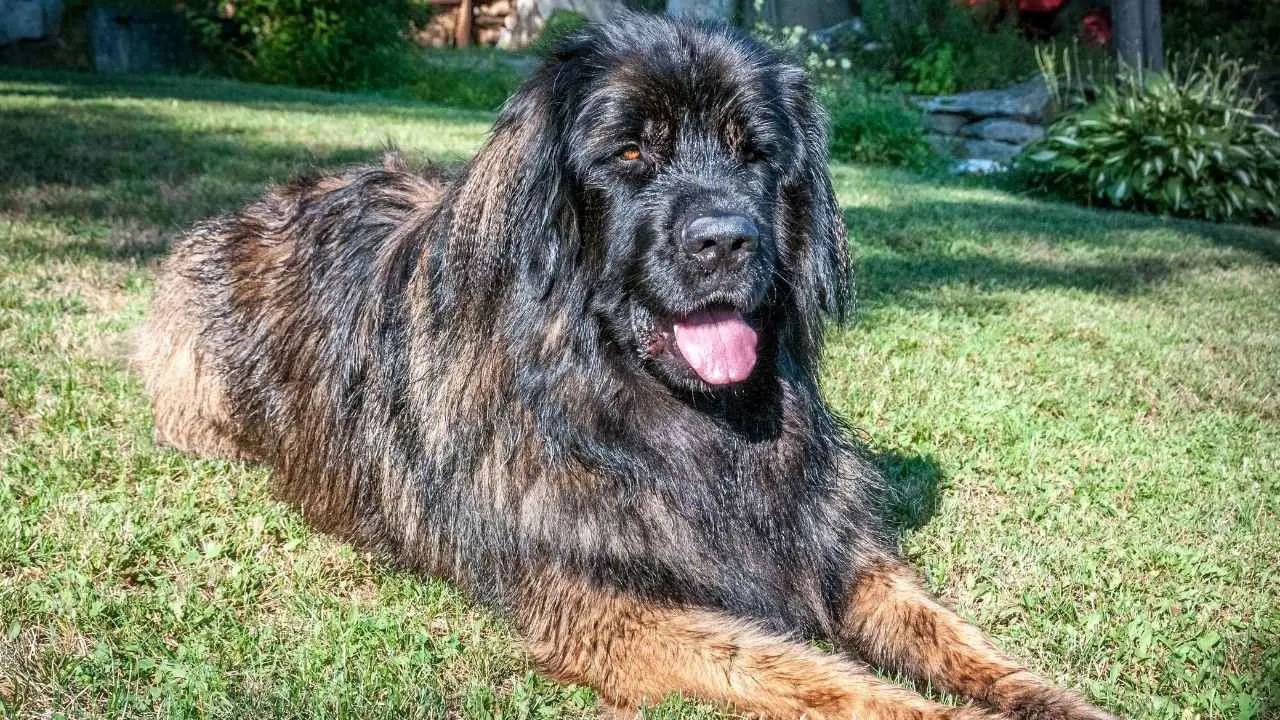
The Leonberger is a majestic, affectionate giant known for its gentle temperament and lion-like appearance. Originally developed in Germany, this breed blends impressive size with a surprisingly playful and family-friendly demeanor.
Males typically weigh between 110 to 170 pounds and stand 28 to 31 inches tall, while females are slightly smaller. Despite their size, Leos are calm and sociable, making them ideal canine companions for households with children and other pets.
Their black facial mask, expressive brown eyes, and regal mane around the chest and neck contribute to their noble and kind expression.
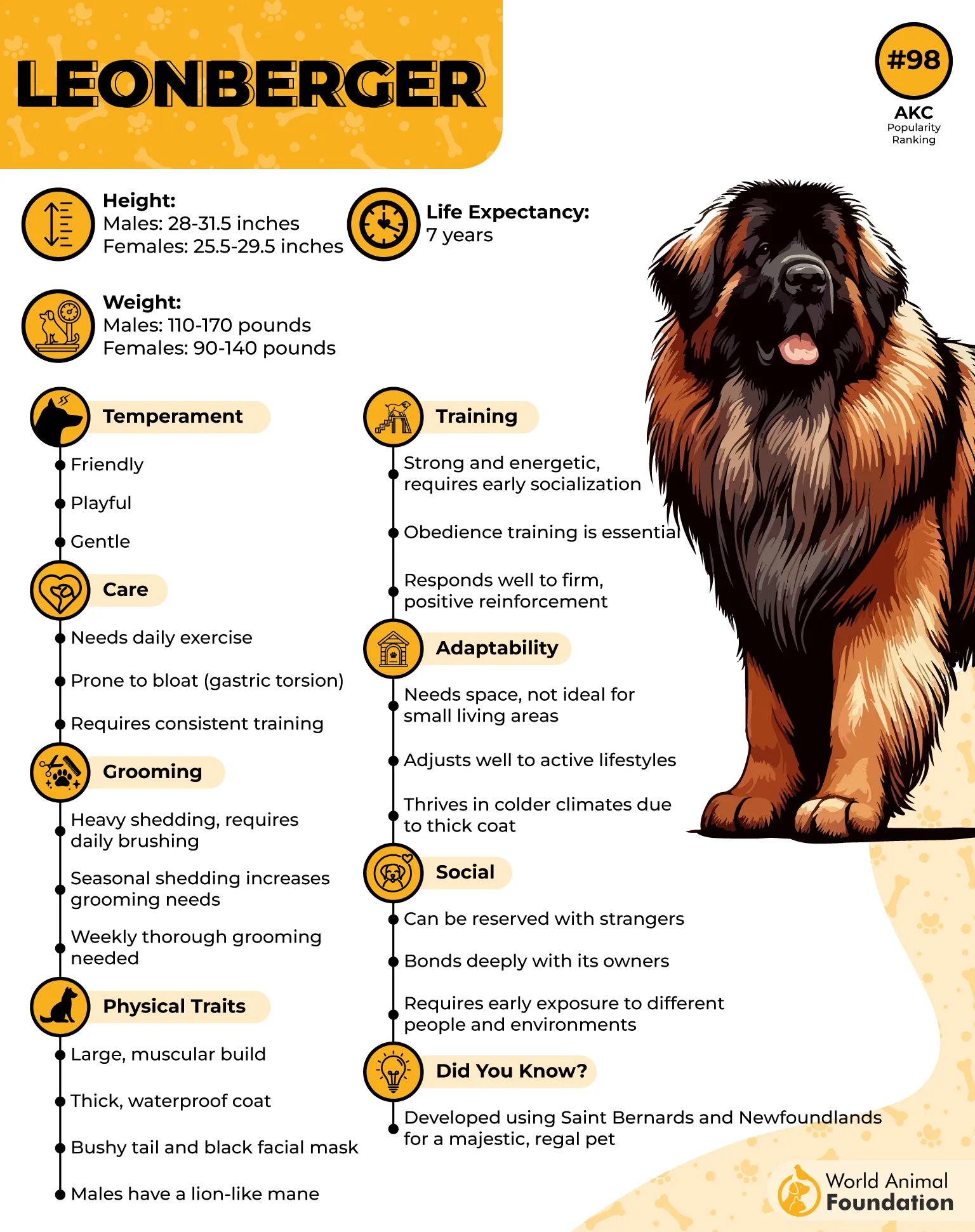
Health
This is one of the healthiest dog breeds. Leonbergers tend to have fewer health issues compared to some other large breed dogs, but they are still prone to certain inherited conditions.
These include laryngeal paralysis, which affects their breathing and vocalization, and bloat (gastric dilatation and volvulus), a life-threatening condition common among deep-chested dogs.
Preventative care, such as careful feeding practices and awareness of early symptoms, is essential. Their average life expectancy ranges from 7 to 9 years, which is typical for dogs of their stature.
Fact: Leonbergers are powerful yet gentle giants, easily trainable and well-suited to family life with children and other animals.
Conclusion
Understanding the average lifespan of different dog breeds is essential for prospective dog owners and pet parents alike. From the gentle Bernese Mountain Dog to the majestic Leonberger, lifespan varies significantly across size and breed. While giant breeds often live between 7–12 dog years, medium-sized dog breeds may enjoy a slightly longer lifespan with proper care, exercise, and quality dog food. Recognizing these differences can help pet owners make informed decisions that align with their lifestyles and long-term commitments.
Some of the longest-living breeds, such as the energetic Jack Russell Terrier and loyal Australian Cattle Dog, regularly surpass average expectations. Even mixed-breed dogs, which often benefit from diverse genetics, can enjoy robust health and longevity. As senior dogs require different care, understanding breed-specific aging helps support their changing needs. Whether it’s a Russell Terrier, Labrador Retriever, or Cavalier King Charles Spaniel, responsible dog ownership begins with knowing what each breed’s lifespan entails.


